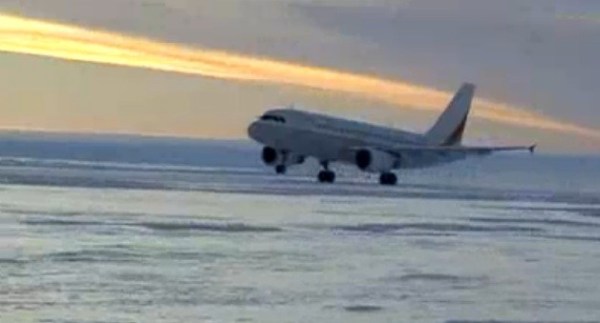
For a second season the Wilkins blue ice runway in Australian Antarctic territory is closed because of warm conditions.
Comparatively warm of course. But too warm to even open it to flights by the Airbus A319 operated for the Australian Antarctic Division by Skytraders. The irony of this mightn’t amuse too many of the northern hemisphere travellers held up by real snow at many airports, or by management incompetency in the case of the fools running London Heathrow when faced with a light snow fall.
This YouTube (below) shows an what it is like to use the Hobart-Wilkins service, which lands in the middle of the night while the sun remains low above the horizon during the peak ‘summer’ months.
YouTube has made some more changes to its embed codes that WordPress doesn’t like, so you will have to use this link to see it but it is worth watching and listening to as you hear the main wheels crunch onto the ice from inside the cabin :
https://www.youtube.com/watch?v=XjNkgpsp2Ys



There are several additional things to consider in relation to what is officially called the Wilkins Aerodrome, some 65 kilometres by giant tractor from the Casey Station.
The service between Hobart and Casey has despite its necessarily low frequency, and high costs of establishment, become a very important development in reducing the overall costs of access to Antarctica, not only for the Australian bases, but those of other countries who use Wilkins as a hub for gauge changes from the A319 to smaller turboprops for services to field research sites, and other bases, and also to the highest and most arid interior ice masses known as Dome A and Dome C.
Put beside the environmental and cash costs of shipping scientists to Casey, and heating and feeding them for the best part of a full year until the ice breaker returns, the Wilkins service means research missions can (usually) be run over a period of only weeks.
The Wilkins Aerodrome also serves to support Australia’s relevance and participation in international agreements concerning the future of the continent of ice.
Nor is the jet currently unemployed. It has been flying many missions for weeks already between Christchurch and the ice runway (and on occasions also the sea ice runway) at McMurdo Sound, making good money for both Skytraders and the AAD, who share that charter revenue earned by supporting other Antarctic programs but mainly by augmenting the US airlift.
In fact the McMurdo flights, which also operated in the previous Antarctic season, show what the A319 can do when it is possible to refuel the jet in Antarctica. It can fly with 80 people, all wearing their polar gear, and significant freight, whereas at Wilkins, it cannot refuel, and thus often carries around a quarter as much payload in order to meet the fuel load needed for the full return mission and any unpleasant surprises, such as an engine shutdown, which greatly increases fuel burn.
The Wilkins Aerodrome is a natural hub for air access to a very large part of Antarctica, being much closer to many bases than the much more southerly US transport hub at McMurdo Sound.
If Australia is serious about keeping this advantage it will need to do two things. The first improvement would be to provide aircraft refueling for larger jets, so that flights become payload efficient, and thus also providing access to much larger jets than the A319, with jets from other Antarctic treat nations flying to the 4000 metre ice strip through any of the southern Australian cities.
The second improvement would be to actually install an instrument landing system at Wilkins so that much more of the year can be used for air access than at present, and when of course, summer thaws would not be an issue. There is daylight or at worst, a period of bright twilight, during every day of the year at Wilkins. While winter temperatures have fallen on a few occasions to around -40C at Casey during its history it has never been as persistently or deeply cold as the key Siberian, Canadian, Alaskan or northern Scandinavian airfields that manage to remain open year around, and whose existence enables twin engined passenger jets to fly trans polar routes under existing ETOPS rules in the northern hemisphere without seasonal interruptions.
With the Wilkins Aerodrome Australia started something it cannot stop. The demand for airlift to that part of Antarctica is rising as new bases, like an all year China station high on the inland domed ice, come into operation. If Australia doesn’t expand Wilkins to support that activity, there is nothing to stop China or India or Japan deciding to build their own facility, and make us look very short sighted in the process.







Crikey is committed to hosting lively discussions. Help us keep the conversation useful, interesting and welcoming. We aim to publish comments quickly in the interest of promoting robust conversation, but we’re a small team and we deploy filters to protect against legal risk. Occasionally your comment may be held up while we review, but we’re working as fast as we can to keep the conversation rolling.
The Crikey comment section is members-only content. Please subscribe to leave a comment.
The Crikey comment section is members-only content. Please login to leave a comment.